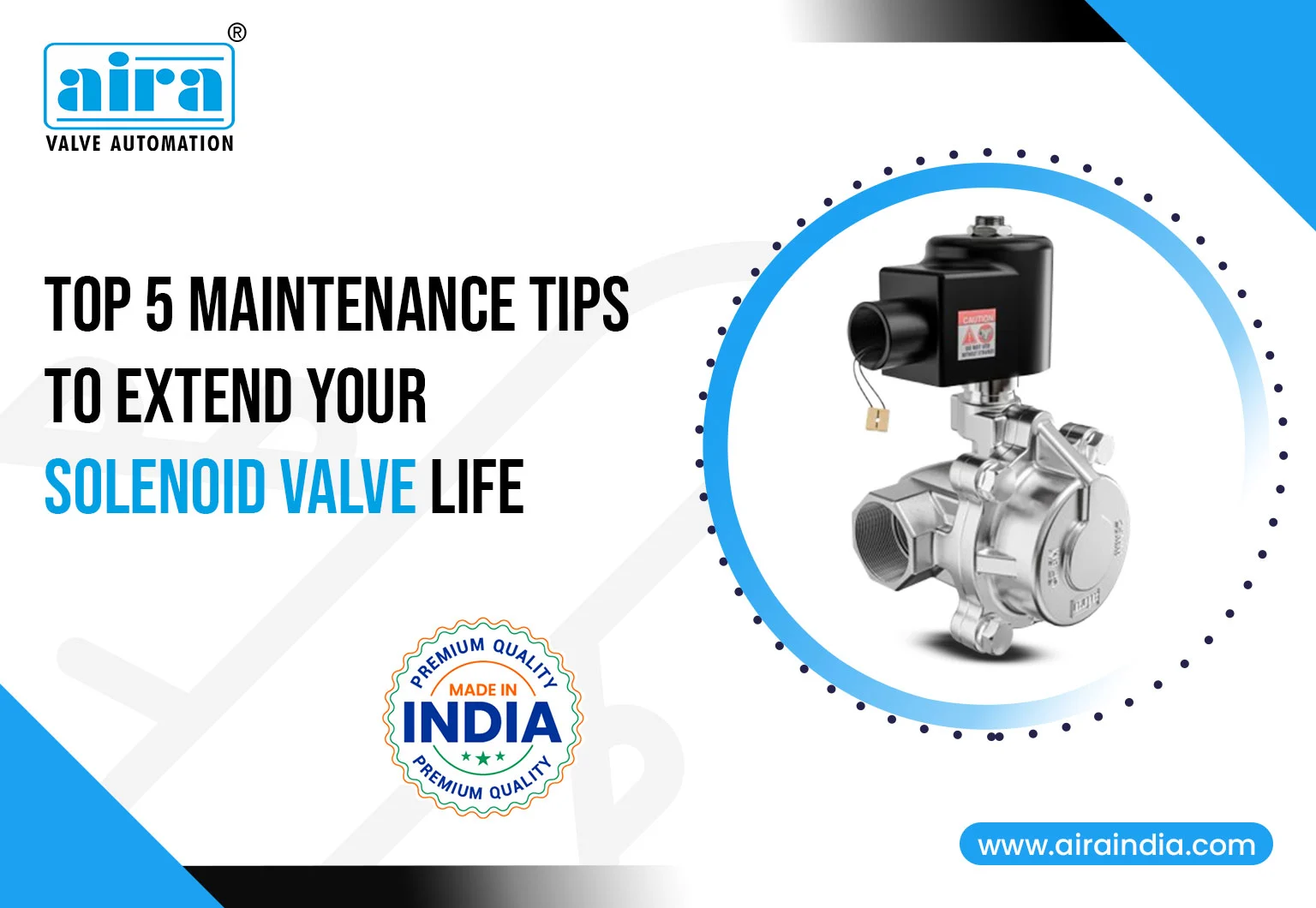Solenoid valves are essential components in industrial automation and process control systems, regulating the flow of air, water, steam, oil, and chemicals with accuracy. Despite their durability, many solenoid valves fail prematurely due to poor maintenance practices or oversight. At Aira Euro Automation, we understand the high cost of downtime and repairs caused by valve failures. That’s why we’ve put together five simple yet highly effective solenoid valve maintenance tips to help you extend the service life of your solenoid valves, whether they are direct-acting or pilot-operated.
Keep Solenoid Valves Clean & Free of Debris
One of the most common reasons for solenoid valve malfunction is blockage caused by contaminants in the fluid line. Foreign particles can clog the valve seat, plunger, or internal orifices, resulting in sluggish operation, leakage, or complete valve failure.
To prevent such issues:
- Clean inlet filters regularly, especially in dirty water or outdoor applications.
- Flush the piping system before installing new solenoid valves to remove sediment and debris.
- Install strainers or filters in the upstream fluid lines to stop solid contaminants from entering the valve body.
- Inspect and clean internals on a regular schedule, weekly in water or dirty fluid applications, and monthly in compressed air systems.
These maintenance habits will drastically reduce the chances of blockages and keep your solenoid valve performing optimally.
Regularly Inspect Coils & Electrical Connections
The electrical coil is the heart of a solenoid valve. Over time, heat, moisture, or power fluctuations can cause the coil to degrade or fail. Routine inspection helps avoid unexpected malfunctions that disrupt system performance.
Maintenance steps include:
- Check for visible damage such as cracks, burns, or discoloration on the coil housing.
- Verify voltage and amperage levels match the coil’s rated requirements.
- Ensure tight and corrosion-free wiring connections.
- Protect outdoor or wet-environment installations with IP-rated enclosures to prevent water ingress.
- Watch for signs of coil failure like buzzing noises, excessive heat, or sluggish actuation.
Only use manufacturer-approved replacement coils to maintain performance and safety standards.
Monitor Media Compatibility
A major but often overlooked cause of solenoid valve failure is incompatibility between the valve materials and the fluid media. Using the wrong valve body or seal material can lead to chemical corrosion, swelling, or brittleness.
Here’s what to do:
- Match the valve materials (e.g., brass, stainless steel, or plastic) with the specific chemical, gas, or liquid being controlled.
- Check the seal compatibility, FKM is ideal for oils and fuels, EPDM for hot water and steam, and PTFE for aggressive chemicals.
- Re-evaluate compatibility if the media changes. For example, acidic chemicals can quickly degrade brass valves.
- Consult datasheets or compatibility charts from trusted manufacturers like Aira Euro Automation to make informed decisions.
Proactive selection ensures the valve can handle your specific application without failure.
Control Pressure Surges & System Stress
Solenoid valves are mechanical devices and, like all hardware, they can suffer from pressure-related damage if not properly managed. Rapid pressure spikes can damage internal components such as diaphragms, plungers, or seals, leading to leaks or failures.
Follow these strategies to control pressure:
- Use pressure regulators to maintain a steady system pressure.
- Install soft-start valves or accumulators to absorb shock during startup or shutdown.
- Avoid opening or closing valves suddenly under full system pressure this can “slam” the internals and reduce lifespan.
- Verify that system pressure stays within the valve’s maximum operating pressure range, as exceeding it will cause long-term damage.
- Prioritize pressure control in high-impact systems like hydraulic lines, steam networks, or high-viscosity fluid processes.
Also, read Choosing Between Pilot Operated and Direct Acting Solenoid Valves
Pressure regulation is one of the most critical steps in preventing solenoid valve failure and extending component life.
Schedule Preventive Maintenance & Testing
The best way to ensure reliable solenoid valve performance is to establish a preventive maintenance plan. Many facilities wait for failure to occur before taking action, but proactive inspection can save both time and money.
An effective maintenance plan should include:
- Visual inspections for corrosion, leakage, or unusual wear
- Functional testing to verify actuation timing and responsiveness
- Leak checks and cycle testing
- Logging all maintenance activity to identify patterns or recurring issues
- Pre-scheduled replacement of seals or diaphragms, based on usage cycles or time intervals
Depending on your application, maintenance intervals can range from monthly to quarterly. Tracking performance data will help prevent unplanned downtime and optimize production efficiency.
Conclusion
Solenoid valves play a vital role in keeping industrial processes flowing smoothly. With just a few preventive actions, like cleaning, inspecting, regulating pressure, checking compatibility, and scheduling maintenance, you can significantly increase the lifespan of your solenoid valves.
Doing so not only reduces repair costs and downtime but also ensures safety, reliability, and long-term performance.
Need maintenance-friendly solenoid valves or expert support?
Contact Aira Euro Automation, a trusted name in high-performance solenoid valve solutions. Our team can help you select and maintain solenoid valves that match your system requirements perfectly.
